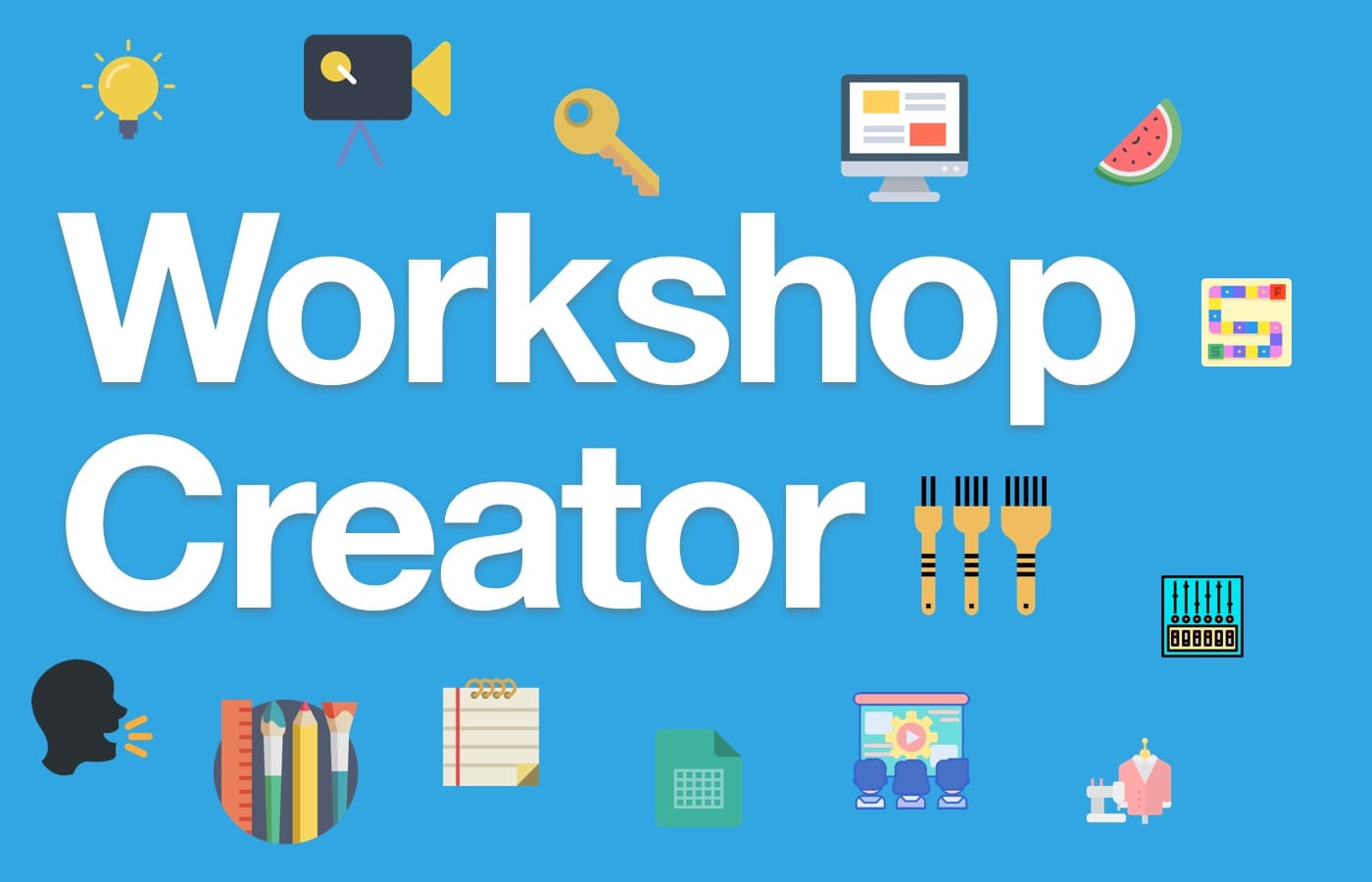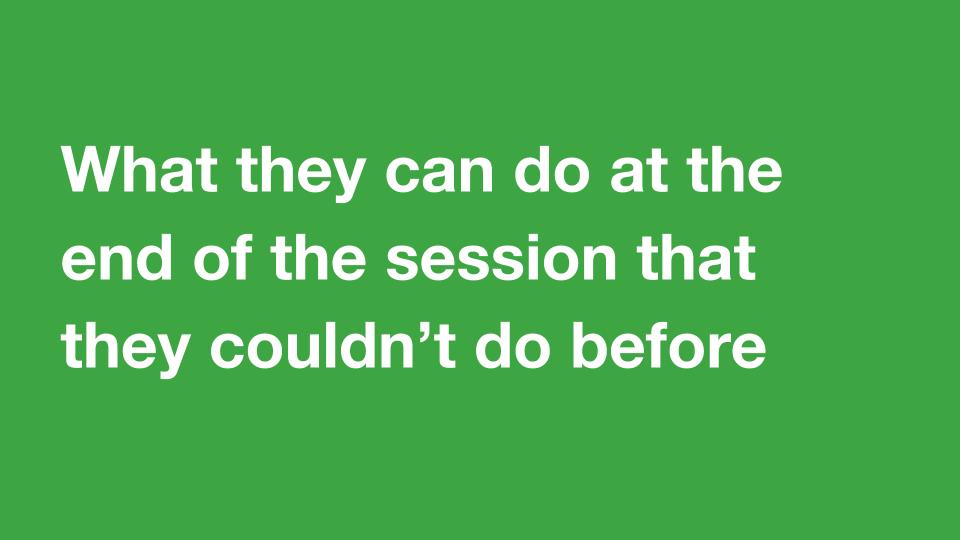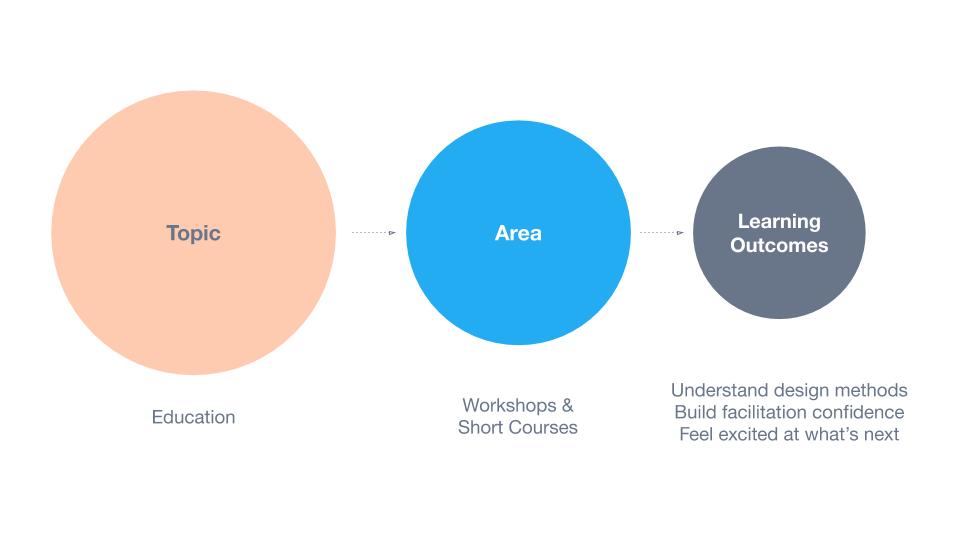Workshop Creator - Lesson #2: Learning Outcomes

In this lesson we’re going to focus on the why and the what:
- Why you’re putting this together for your audience
- What you want them to take away from your session
You can encapsulate this through a small number of well-defined learning outcomes.
Learning outcomes get you focused on the purpose and desired outcomes of your session.
In this lesson, you’ll learn how to drill down from your broader overarching topic to a more closely defined area, before creating your key learning outcomes.
You’ll also learn the importance of having strong pillars to sit underneath your learning outcomes, and how using the power of persuasion can help you unearth a compelling learning outcomes.
Combined with a good understanding of your audience, after this lesson you’ll have a strong sense of the ‘Who’, ‘Why’ and ‘What’ of your workshop so you can start pushing on into the ‘How’ – creating a strong structure and compelling content.
Let’s get started.
Introducing Learning Outcomes

Simply put, learning outcomes are describe what your attendees can do after completing the workshop.
This is worth reiterating; it’s subtle, but HUGE.
We can think of Learning Outcomes as:
What they can do after the session that they couldn’t do before
Without clear learning outcomes, it’s unlikely your workshop will get the interest it deserves, nor that attendees will get what they came for. Bad news all round.
The good news is clear learning outcomes do a lot of the heavy lifting for the rest of your workshop design.
They’ll make the content easier to put together, and, as you’ll see in the next lesson, provide the central core of your workshop structure.
Here’s how we can start thinking about learning outcomes:

Note: You may also hear the terms ‘learning goals’ or ‘learning objectives’; these are similar to learning outcomes. but there are important distinctions. Outcomes are generally broader in scope, but lean toward action (which is good for us as workshop creators). Learning objectives are more specific and measurable but focus on what something strives to achieve, rather than the outcome for the participant.
So how we can start thinking about our learning outcomes?
Here’s our quick start guide to sculpting learning outcomes.
- Limit your learning outcomes to a maximum of 3
- Use a framing question
- Use a single action verb
That’s it. 3 steps. Let’s get into it.
Step 1: The magic number
Three is indeed the magic number, or, in the case of your learning outcomes, the maximum number.
Just 1 or 2 learning outcomes are totally fine too (and definitely recommended if you’re just starting out and/or are running a shorter session), but going above 3 is where you’re likely to come unstuck.
Trying to cram in 4, 5, or 6 learning outcomes is going to risk you skimming over content, going too quickly, or confusing your audience.
Focus on nailing a small number of key learning outcomes. Less is most definitely more.
Step 2: Framing Questions
To help surface learning outcomes, here’s are a couple of framing questions to ask yourself. First:
Why are you doing this workshop and what do you expect the result to be?
Aim to answer this with yourself in mind while also looking through the lens of your audience. This may sound paradoxical but it’s pretty simple. Here are a few examples:
‘I want them to [X], and be able to go out and [Y]’
‘I know that people who do [X] struggle with [Y]. If they can understand [Y] better, they’ll be able to do [X] and [Z].’
‘People who are interested in [X] have told me they love the idea and want to know more about it. I know [Y] is something that will really help them here, and it’ll also help position me as an expert in [Y] (and help me get to [Z], which is something I’ve had as a goal for ages’
The second framing question you can use is:
What am I trying to convince them of?
This question is slightly different. I find it’s particularly helpful to surface objections or areas that may be confusing about a topic. You’ll end up with an answer along the lines of:
‘Because [topic] is really [positive adjective or description], but people usually think it’s [negative adjective or description]’
‘Because calligraphy is really valuable as a skill set for graphic designers, but people usually think it’s old fashioned and redundant‘
As well as learning outcomes, the response to this question often leads to useful marketing copy, activities, and all kinds of other good stuff.
Once you’ve listed out a few answers to your framing questions, it’s time to turn these into learning outcomes.
Step 3: Single action verb
You want to write each learning outcomes as one sentence, including a verb. The learning outcomes should focus on what they can do or create after attending your workshop.
But how can you get to the right verbs?
Introducing Mr. Bloom
Back in 1956, Benjamin Bloom created his Skills Taxonomy as a way to categorize the levels of reasoning skills required in classroom situations.
We can use Bloom’s 6 levels to help us get at some of the verbs we may want to include in our learning outcomes.

Below are Bloom’s 6 skill levels, and some associated verbs.
- Remember
Memorize, show, pick, spell, list, quote, recall, repeat, catalogue, cite, state, relate, record, name. - Understand
Explain, restate, alter, outline, discuss, expand, identify, locate, report, express, recognize, discuss, qualify, covert, review, infer. - Apply
Translate, interpret, explain, practice, illustrate, operate, demonstrate, dramatize, sketch, put into action, complete, model, utilize, experiment, schedule, use. - Analyze
Distinguish, differentiate, separate, take apart, appraise, calculate, criticize, compare, contrast, examine, test, relate, search, classify, experiment. - Evaluate
Decide, appraise, revise, score, recommend, select, measure, argue, value, estimate, choose, discuss, rate, assess, think. - Create
Compose, plan, propose, produce, predict, design, assemble, prepare, formulate, organize, manage, construct, generate, imagine, set-up.
Sculpting your learning outcomes
Based on your answers to the framing question, choose one of Bloom’s skills and then try out a few of the associated verbs to create a learning outcome.
For example, in our Sustainability for Innovation session we wanted attendees to be able to figure out which Sustainable Development Goals mattered most to their business.
This skill is Evaluation, and the verb ‘Assess’ felt most appropriate.
So the learning outcome was simply:
‘Assess which Sustainable Development Goals are most relevant and timely for your business’
Pro Tip: If you’re feeling unsure about your learning outcome being too loose or vague, try running them against the SMART goals framework
Action:
Try this exercise for yourself, creating 1-3 clear learning outcome for your workshop.
During the creation of your learning outcomes, remember to think back to your audience – who they are, why they’re attending, and what they want to get from the session.
In the next lesson you’ll start creating the structure for your workshop.
See you then 🙂